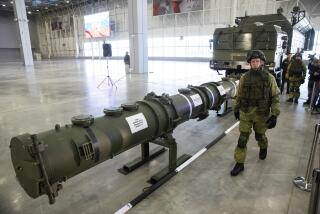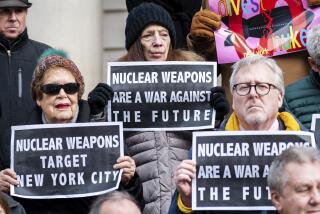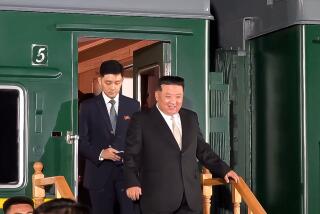U.S., Moscow Set Summit for Fall : Reagan, Gorbachev Will Meet to Sign Mid-Range Missile Treaty
- Share via
WASHINGTON — President Reagan announced Friday that he will meet with Soviet leader Mikhail S. Gorbachev in the United States this fall to sign a treaty outlawing medium-range nuclear missiles, although he said he retains strong doubts about dealing with the nation he once called an “evil empire.”
No specific date for the summit was announced, but officials said it probably will take place in the second half of November. The meeting will start in Washington, but Gorbachev also is expected to visit Reagan’s ranch near Santa Barbara and perhaps other places as well.
Although some details--including such potentially troublesome issues as verification--remain unsettled, the United States and the Soviet Union issued a joint statement that treated as almost an accomplished fact a treaty banning the two classes of nuclear weapons within the intermediate-range category--missiles with ranges of 300 to 600 miles and those with ranges of 600 to 3,000 miles.
“In order to sign a treaty on medium-range and shorter-range missiles and to cover the full range of issues in the relationship between the two countries, a summit between President Reagan and General Secretary Gorbachev will take place . . . in the fall of 1987,” the statement said.
Secretary of State George P. Shultz and Soviet Foreign Minister Eduard A. Shevardnadze, who hammered out an agreement in principle covering the remaining issues, scheduled a meeting in Moscow for late October to set a specific date for the summit conference and to tie up the loose ends of the negotiations.
Shultz and Shevardnadze, speaking at separate press conferences, said that relations between the two countries are far more businesslike and orderly than they were earlier in the Reagan Administration, when the two nations were exchanging little more than insults.
But when Reagan was asked during a fractious appearance in the White House press room how he could make a deal with the nation he once referred to as an “evil empire,” he replied that he still did not consider the Soviet Union to be “lily white.”
And, when asked if he was in too much of a hurry to conclude an arms control agreement, Reagan said: “I don’t know of anything in my life I waited over six years for.”
1st Arms Pact Since 1979
The pact would be the first U.S.-Soviet arms control agreement since then-President Jimmy Carter and the late Soviet leader Leonid I. Brezhnev signed the second strategic arms limitation treaty in 1979.
Reagan said that the latest treaty was the result of proposals that he first presented in 1981.
Shultz and Shevardnadze, assisted by about 75 experts on both sides, settled two key arms control issues during three days of talks this week. They left to the arms control negotiators in Geneva the remaining disagreements, which officials on both sides described as technical. The arms negotiators were told to complete their work before Shultz and Shevardnadze meet in Moscow next month.
Officials on both sides said that the remaining issues include the number of on-site inspections to ensure compliance with the treaty--once a hotly controversial issue--and the pace at which missiles will be destroyed. Such matters have been known to tie negotiations in knots for months or even years. But, prodded by the summit schedule, the negotiators could settle the remaining matters by compromises.
A U.S. official said the two sides agreed in principle to permit on-site inspections to police the treaty. But he said that differences remain on the number of unscheduled “challenge” inspections to be allowed. Moreover, he said, Washington wants the treaty to allow inspectors to go anywhere that they suspect a violation has occurred while Moscow wants to restrict their activities to agreed-upon sites.
Disagreement on Schedule
Another U.S. official said that there is also a disagreement on the schedule for destroying the missile systems. The Soviets want to allow two years for destruction of shorter-range systems and five years for dismantling of medium-range systems, while the United States proposes one year and three years.
In addition, the Soviets want to require the removal of the nuclear devices from the missiles within one year, in effect rendering them useless. Washington maintains that such a requirement could not be verified adequately.
Despite the progress on banning medium-range nuclear arms, the United States and the Soviet Union remain far apart in their negotiations on long-range strategic weapons and on space and defensive systems. Reagan and Gorbachev agreed last year at their meeting in Reykjavik, Iceland, to aim at a 50% cut in strategic weapons, but Shultz and Shevardnadze agreed that little progress has been made since then in determining the details.
Both sides declared strategic arms reduction to be a high priority for the remaining 16 months of the Reagan Administration but, U.S. and Soviet officials said, few compromises have been offered.
One senior U.S. official said that the two most troubling issues at the start of the Shultz-Shevardnadze talks this week were the disposition of U.S.-controlled warheads on 72 West German-owned Pershing 1-A missiles and of warheads from the U.S. and Soviet missiles to be destroyed under the treaty. As it turned out, the official said, the two sides were closer than their public statements would have indicated, so compromise was fairly easy.
Moscow’s Demand on Warheads
For several months, Moscow has demanded that the United States agree to destroy the warheads for the Pershing 1-A missiles. Washington refused because it maintained that U.S.-Soviet negotiations could not affect “third country” systems.
The dispute lost much of its steam last month, however, when West German Chancellor Helmut Kohl announced that Bonn would dismantle its missile force once the U.S.-Soviet intermediate nuclear force agreement was implemented. But the Soviets continued to demand that the United States agree in the treaty to destroy the warheads.
Shultz and Shevardnadze papered over the issue by agreeing that once the West German missiles were destroyed, the warheads would revert to the United States and would then be disposed of in the same fashion as other medium-range missile warheads. The West German systems will not be mentioned in the treaty--as Washington demanded--but they and their warheads will be dismantled--as Moscow demanded.
“We both ended up with what we had said was in our interest,” a senior Administration official said.
The issue over the disposition of other warheads proved to be even easier to settle, officials said. The Soviets had implied that they would demand the destruction of the nuclear charge in the warheads, a step that Washington was unwilling to take. But the Soviets agreed with the U.S. position that the nuclear material could be removed and recycled when the rest of the warhead was dismantled.
More to Read
Sign up for Essential California
The most important California stories and recommendations in your inbox every morning.
You may occasionally receive promotional content from the Los Angeles Times.










